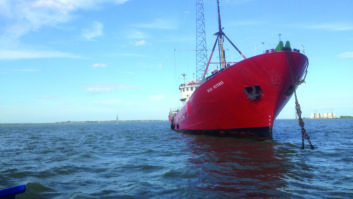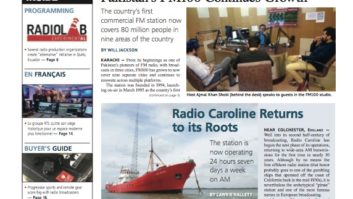Well into its second half-century of broadcasting, Radio Caroline has begun the next phase of its operations, returning to wide-area AM transmissions for the first time in nearly 30 years. Although by no means the first offshore radio station (that honor probably goes to one of the gambling ships that operated off the coast of California back in the mid-1930s), it is nevertheless the archetypical “pirate” station and one of the most famous names in European broadcasting.
After some 26 years of unlicensed operations from international waters, off the British and Dutch Coasts, Radio Caroline finally ceased its offshore “pirate” broadcasts in November 1990, just a few weeks before the British government introduced tough new laws against such activities.
Land-Based Broadcasting
Its final radio ship, the “MV Ross Revenge” stayed at anchor, but off air, for about another year, before losing its anchor in a storm and then running aground on the infamous Goodwin Sands off the coast of Kent in November 1991. Unusually, the ship survived its encounter with the sandbank and was salvaged and then towed into the port of Dover, although its ownership at that time was somewhat unclear.
For many broadcasters the change in the law and the loss of its broadcasting base would have brought operations to an end. However, the popularity of the station, its history and the enthusiasm of its team soon saw the station implementing alternative forms of broadcasting.
In a way, the timing for the station worked to its advantage. Changes to United Kingdom broadcasting law in the late 1980s initially allowed the station to carry out various low-power short-term broadcasts on AM, mainly in London and other locations in Kent and Essex.
From the late 1990s onward, the station also began broadcasting via satellite, even getting involved in the WorldSpace satellite radio platform until some 10 years ago. More recently, internet streaming has become increasingly important for the station and all satellite transmissions were ended in 2013, as costs rose and audiences steadily moved to IP-based platforms instead. An additional “Caroline Flashback” stream was launched in 2015 and there are now even time-shifted streams of the main station output for listeners on the East and West coasts of North America.
In 2015, the British radio regulator, Ofcom, began experimenting with open source approaches to small-scale DAB delivery. Using the strapline “Same Ideology — New Technology,” Radio Caroline obtained carriage agreements with several of the experimental multiplex operators, including in Birmingham, Brighton, Glasgow, Norwich, Portsmouth and Woking.
Despite developing its presence across alternative delivery platforms, the station continued to take an active interest in getting back to its AM broadcasting roots. In 2010, politicians in the British Parliament called for Caroline to be given a new license to serve its traditional heartlands of London and the South East of England.
Back to AM
In 2015, Radio Caroline began to take make progress with its AM broadcasting ambitions, reaching an agreement with “Manx Radio” on the Isle of Mann in the Irish Sea between Britain and Ireland to broadcast (on 1368 kHz at 20 kW EMRP) one weekend a month, but originating the programs from its, now restored, former home, the MV Ross Revenge, located at a river anchorage in Essex.
At about the same time, Ofcom, was looking again at what to do with some other AM (medium wave) frequencies no longer needed by existing licensed broadcasters and decided that some could be used for community radio services across parts of the country.
[READ: AM Transmitters to Close in U.K.]
One such frequency was 648 kHz. This low frequency with excellent long-range propagation characteristics is cleared for U.K. use at power levels of just above 40 kW (omnidirectional) rising to over two megawatts in some directions toward northern Europe and the former Soviet Union.
Used by the BBC for many years until 2011 it was eventually taken out of use completely in May of the following year. The BBC broadcast on 648 kHz from a transmission base at Orfordness right on the East Coast of England, using the former military “Cobra Mist” transmitting station originally built in the late 1960s to house an experimental over-the-horizon radar system.
Old Site Welcomes New User
Although almost all the original broadcasting equipment was stripped out after the end of broadcasting in 2012, the antenna systems remained intact and available for use.
When in 2016, Ofcom invited applications for new AM community radio licenses, the problem for Radio Caroline was fitting its activities into a licensing regime that is primarily intended for very local, geographically-focused community broadcasting organizations.
By comparison, Radio Caroline has always been a music-based station broadcasting to a target audience that is not concentrated in any specific geographic location. Most U.K. community radio stations operate on FM with a typical coverage radius of between five and 10 kilometers. AM community radio stations are much less common, but do tend to cover a larger radius, usually of up to around 20 kilometers.
For Radio Caroline such limited coverage would be difficult to accept, primarily because much of its audience base could not be served. Fortunately for the station, the availability of 648 kHz with its international clearance for use at very high power levels provided Ofcom with the ability to accept its proposals to cover a somewhat larger geographical area.
Although it had planned to build new facilities from scratch, after the license was awarded discussions with the current owners of the Orfordness transmission facilities lead to a cost-effective change of plans and the use of the old BBC facilities instead.
Under its new license, Radio Caroline is permitted to broadcast with a radiated power of 1 kW, not a particularly high-power service in terms of its earlier offshore activities. However, given the lack of incoming interference on the frequency, and its long-wavelength signals, the result is effective coverage that, in practice, for many listeners is larger than planning criteria might suggest.
In many ways, Radio Caroline has both kept up with the times in terms of the broadcasting technologies it uses and come full circle with its recent return to AM broadcasting.
The similarities between 1964 when the station began operations and today are even greater. When broadcasting from the high seas, the station had to be supplied by boat. In 2018 the station’s private Orfordness transmitter site is also accessed mainly by boat!
Dr. Lawrie Hallett lectures at the University of Bedfordshire and reports on the industry for Radio World from Norwich, England.










